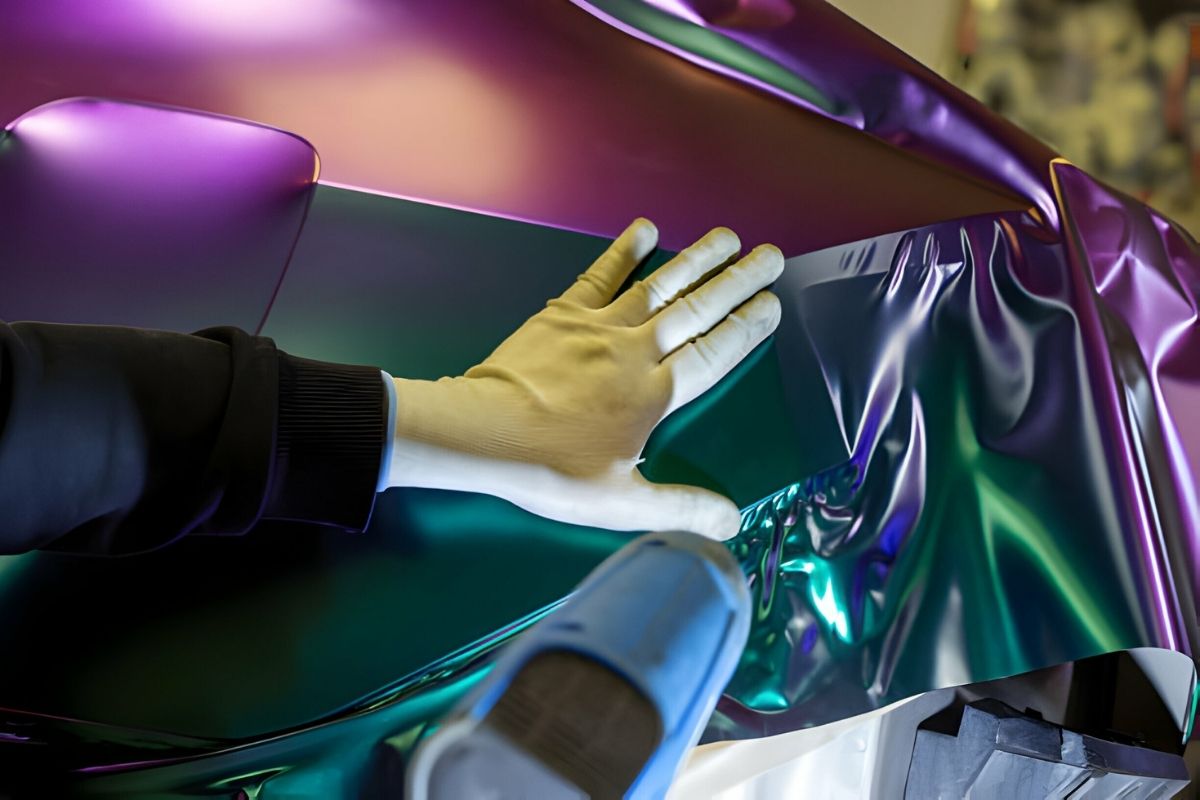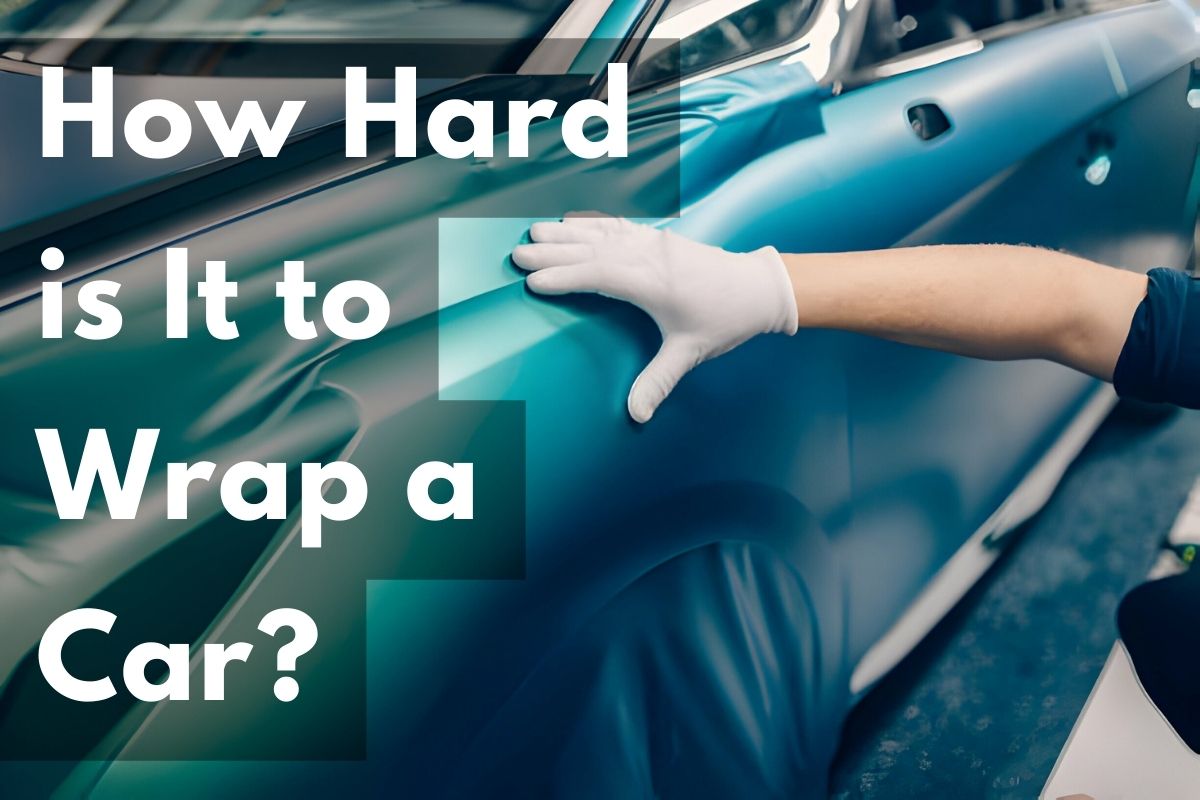Wrapping a car can be challenging, requiring patience and skill. It’s not an easy task for beginners without proper guidance.
Car wrapping involves meticulously applying large vinyl sheets to a vehicle’s exterior, conforming to its contours and curves. Mastery of this method demands time, attention to detail, and a steady hand. Seasoned professionals can achieve a flawless finish, transforming a car’s appearance without the need for a full paint job.
For those considering this as a DIY project, it’s crucial to understand that car wrapping is more than just sticking on decals – it’s an art that can protect your vehicle’s paint and give it a completely fresh, custom look. Proper wrap installation reduces the likelihood of bubbles, creases, and potential peeling, ensuring a sleek, durable result.
Why Wrap A Car?
Revamping your ride goes beyond personal style. A car wrap is a robust film that covers the surface of your vehicle. Why consider wrapping your car? Let’s explore.
Preservation Of Original Paint
Wrapping a car is like giving it a shield. The original paint stays pristine underneath, safe from the elements. This paint preservation means maintaining your car’s resale value. A wrap can keep that just-off-the-lot look for years. Some key points include:
- Shielding the paint from harsh weather
- Retaining the car’s brand-new shine
- Making sure of a higher resale value
Protection Against Scratches And Fading
Think of a car wrap as a guardian for your vehicle. It protects against everyday wear and tear. Scratches and dents don’t stand a chance. The sun can also cause damage over time. But with a wrap, the threat of fading and discoloration is much less. A wrap delivers:
- Resistance to minor scrapes
- A barrier from UV rays, preventing fade
- An overall lasting appearance
Understanding Car Wrapping

Car wrapping is a popular trend in vehicle personalization. It involves sheer skill and precision. A wrap covers your vehicle in a thin layer of vinyl. This upgrade is not just about looks. It protects the paint too. But is it hard to do? Let’s dive in.
What Is Car Wrapping?
Car wrapping is like giving your car a new skin. It’s a process where a vehicle gets covered with vinyl. This vinyl can showcase colors, designs, or even advertisements. The layer is not permanent. Owners can remove or change it with ease. The original paint stays safe underneath.
Different Types Of Wrapping Materials
Diverse materials bring different finishes and lifespans. Some popular options include:
- Cast Vinyl: Premium quality, long-lasting, and flexible.
- Calendar Vinyl: Cost-effective, suitable for short-term use.
- Carbon Fiber: Creates a textured, high-end look.
- Chrome: Gives a mirror-like finish, and stands out.
- Matte: Provides a non-shiny, modern appearance.
Each type of wrapping material has its own application method. The choice depends on budget, desired look, and the car’s shape. Professional installers can advise on the best option for your vehicle. Remember that the installation quality is key for a flawless finish.
| Material Type | Finish | Typical Lifespan |
|---|---|---|
| Cast Vinyl | Various (Glossy, Matte, etc.) | 5-7 years |
| Calendar Vinyl | Less flexible | 1-3 years |
| Carbon Fiber | Textured | 5+ years |
| Chrome | Mirror-like | 2-3 years |
| Matte | Non-shiny | 3-5 years |
Factors Affecting Level Of Difficulty
Wrapping a car changes its look completely. Yet, some find the task tough. The difficulty varies based on several factors.
Wrapping a car is an art. The skill of the person doing it matters a lot. A pro will likely find it easy. Newbies might struggle. Experience plays a huge role in how smooth the process goes.
- Knowledge of materials: Pros know the best vinyl to use.
- Techniques: They have tricks to avoid bubbles and wrinkles.
- Speed: Experience means faster work.
Complexity Of Car’s Body And Features
Different cars have different curves and edges. Some are a wrap installer’s dream. Others? Not so much.
| Car Type | Difficulty Level |
|---|---|
| Sports Cars | High |
| SUVs | Medium |
| Sedans | Low |
Cars with simple shapes are easier to wrap. Think sedans. Cars with swooping lines? Like sports cars, they’re tougher. More curves mean more cutting and precision.
Steps Involved In Car Wrapping

Transforming your car’s appearance might seem like a magic trick. But behind the transformation lies a genuine process. Car wrapping is a task that requires precision, patience, and the right steps. Let’s pull back the curtain on what it takes to wrap a car and highlight the main stages each car goes through during this makeover.
Surface Preparation
Think of surface preparation as laying the foundation for a masterpiece. The vinyl needs to stick properly. Cleanliness is key here. The process starts with a thorough wash, making sure no dirt or grime is left behind. Then, every inch of the car surface gets a detailed inspection to find and fix imperfections. Any traces of wax or oil are removed with a special grease-cutting agent.
Vinyl Application
Now comes the exciting part: applying the vinyl. Patience is the name of the game. Starting from the center and moving outwards, the vinyl is laid gently onto the car. A squeegee helps to push out any air bubbles, ensuring a smooth and seamless finish. It’s a bit like using a sticker, but with much larger and trickier surfaces to cover.
Trimming And Finishing
The final step gives the wrap its crisp, professional look. Precision cutting tools come into play, trimming excess material and tucking the vinyl into crevices. Heat guns help the vinyl wrap adhere to the contours of the car, ensuring no corner peels up or looks unfinished. Once all pieces are cut and sealed, the car is left to cure, bonding the wrap to the car securely.
Potential Challenges And Solutions
Wrapping a car can give it a brand-new look without the costs of a complete paint job. But it’s not always a smooth ride. The process can be tricky, with a few bumps along the way. Let’s talk about some common troubles and their fixes.
Adhesive Bubbles And Wrinkles
Ever seen a sticker full of air bubbles? That’s what can happen when wrapping a car too. Bubbles and wrinkles not only look bad, but they also damage the wrap’s integrity. Here’s what we can do:
- Use a heat gun: Gently heat the area to make the vinyl more pliable.
- Squeegee technique: Push the air outwards from the bubble’s center using a squeegee.
- Puncture method: For stubborn bubbles, carefully puncture with a pin and smooth out the air.
Overstretching And Lifted Edges
Stretching vinyl too much can cause it to thin and fail. Edges can lift, leading to premature wrap peeling. Keep your wrap intact with these steps:
- Proper heat application: Evenly apply heat to avoid overstretching the vinyl.
- Use primer: Apply a wrap primer on the edges to ensure a stronger adhesion.
- Post-wrap care: Regularly inspect and press down any lifting edges.
Frequently Asked Questions Of How Hard Is It To Wrap A Car
What Is The Hardest Part Of Wrapping A Car?
The hardest part of wrapping a car is managing intricate curves and edges. These areas require precision and patience to ensure a seamless finish without wrinkles or bubbles.
What Are The Disadvantages Of Wrapping A Car?
Wrapping a car can reduce paint breathability, potentially trapping moisture and causing corrosion. Over time, the wrap might peel or fade, requiring replacement. Improper application can also lead to air bubbles or wrinkles. Lastly, wraps may not provide as much protection as high-quality paint jobs.
How Long Will A Car Wrap Last?
A car wrap typically lasts between 5 to 7 years, depending on maintenance and environmental conditions. Regular care can extend its lifespan.
Is It Cheaper To Wrap Or Paint A Car?
Wrapping a car is typically cheaper than painting it. Paint jobs can be more costly due to the labor and materials required.
Conclusion
Wrapping a car is a task that varies in complexity depending on the vehicle and the wrap quality desired. It requires patience, precision, and a bit of skill. Whether for business branding or personal style, it’s clear that achieving a professional finish is doable with the right approach and resources.
Remember, practice makes perfect, and a flawless car wrap can be just a project away.




